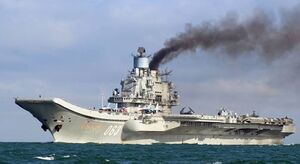Congression-Class Cruiser/Carrier
 LNS Charter (AC-18)
| |
| Class overview | |
|---|---|
| Builders: | Librira |
| Operators: |
|
| Preceded by: | Premier-Class |
| Succeeded by: | none |
| Built: | 1986-1992 |
| In commission: | 1989-present |
| Planned: | 3 |
| Completed: | 2 |
| Cancelled: | 1 |
| Active: | 1 |
| Laid up: | 1 |
| General characteristics | |
| Type: | Cruiser/Carrier |
| Displacement: | 55,000 tons normal load |
| Length: | 305 m (1,001 ft) |
| Beam: | 72 m (236 ft) |
| Draft: | 11.5 m (38 ft) |
| Propulsion: | 2x R-3 Reactors |
| Speed: | 30 knots (56 km/h; 35 mph) |
| Range: | unlimited |
| Complement: | 1500 including crew and troops |
| Sensors and processing systems: |
|
| Armament: |
|
| Aircraft carried: |
|
The Congression-Class Cruiser/Carrier is a class of Cruiser/Carriers operated by the Libriran Navy. The ships are the newest and largest carriers currently in the Libriran Fleet. They were designed in the 1970s and 1980s, to be perhaps the ultimate evolution of the Cruiser/Carrier concept. However, due to their excessive cost only 2 were constructed and 1 of those was laid up to save on operation costs.
Design
Designed to be a more advanced follow on to the Project 18-Class and Premier-Class. The class was intended to be the penultimate Cruiser/Carrier. With a fully carrier deck, in-laid VLS tubes for AShMs, and a nuclear power-plant. Able to utilize the newest in Carrier-converted fighters, missiles, and electronic systems the Congression-Class represented one of the most modern and advanced carriers in the world at the time of its commissioning.
The Design features special VLS tubes for the at the time brand new M-900 AShM. These tubes are inlaid into the flight deck, just aft of the Ski ramp. The tubes house 1 missile per tube, and have doors which are covered in the flight deck surface. They cannot be used while the carrier is launching aircraft, a feature that was possible on the Premier-class. The carrier also features a range of SAMs, CIWS, and AA guns. allowing the Carrier to be covered in every direction from air attack. Against submarines, its features modern SONAR technology, and helicopters and an ASW rocket system to combat submerged foes.
The class features a all-new Air group control system. Developed based on lessons learned from the Premier class, it allows the ships to track and manage both fixed and rotary wing aircraft simultaneously. Additionally it features newer model radar, feature higher resolution, and better tracking capabilities. The radar also is network with the fire-control and air control modules, to provide expedited tracking and targeting data for these systems.
The propulsion system of the ships also used the best Librira had to offer, using a similar Reactor configuration as the City-Class Ultra-Heavy Cruisers, the nuclear reactors avoid some of the problems encountered with gas-fed boilers, and allow the Congression class to have unlimited range, and long power-plant life spans. This also allows the ships to carry more aviation fuel in their bunkers and more munitions. The R-3 reactor the ship uses is a Pressurized water reactor, producing 350mW approx at peak load. the reactor has been rated as very reliable by Libatom and as of yet there have been no reactor related accidents on board the vessels.
Ships of class
| Pennant no. | Name | Laid down | Launched | Commissioned | Homeport | |||
|---|---|---|---|---|---|---|---|---|
| AC-17 | Congrssion | 16 July 1986 | 15 August 1989 | 19 December 1990 | Laid up in Harbraskaya | |||
| AC-18 | Charter | 19 July 1986 | 5 March 1988 | 22 April 1989 | Harbraskaya | |||
| AC-19 | Judiciary | 5 July 1987 | Cancelled 7 June 1989 | N/A | ||||